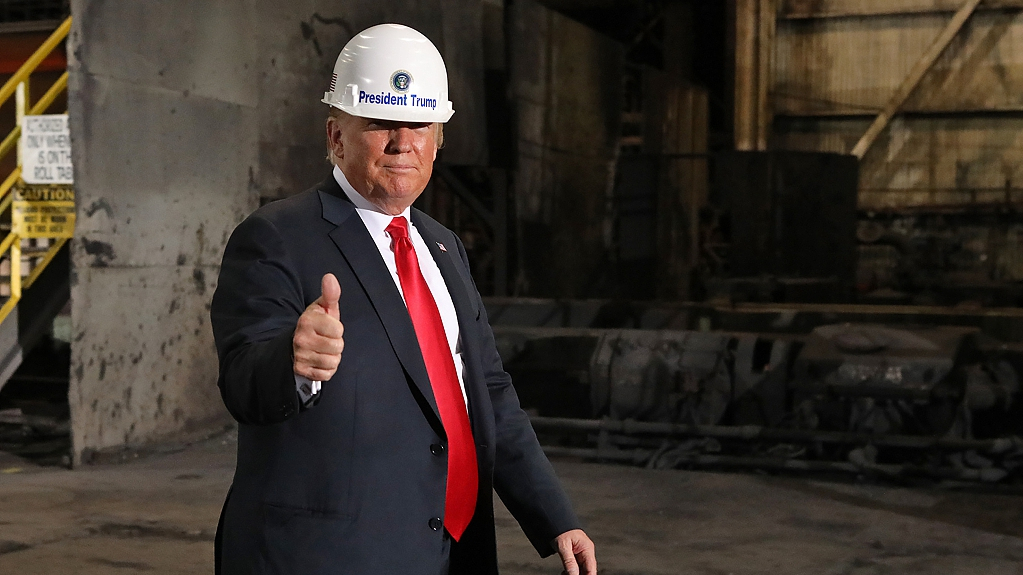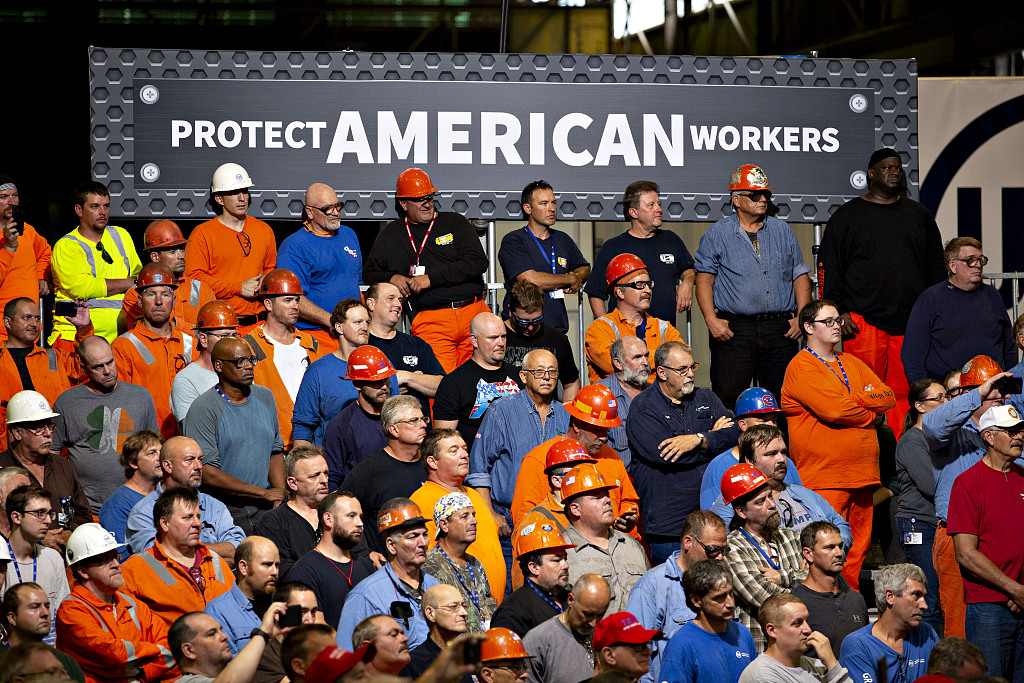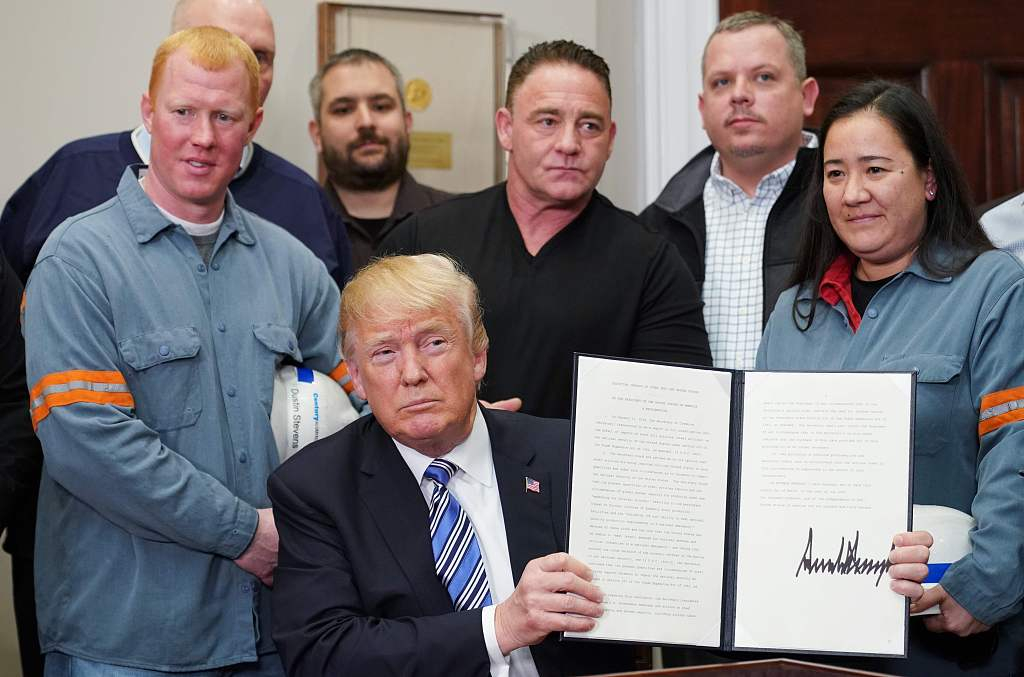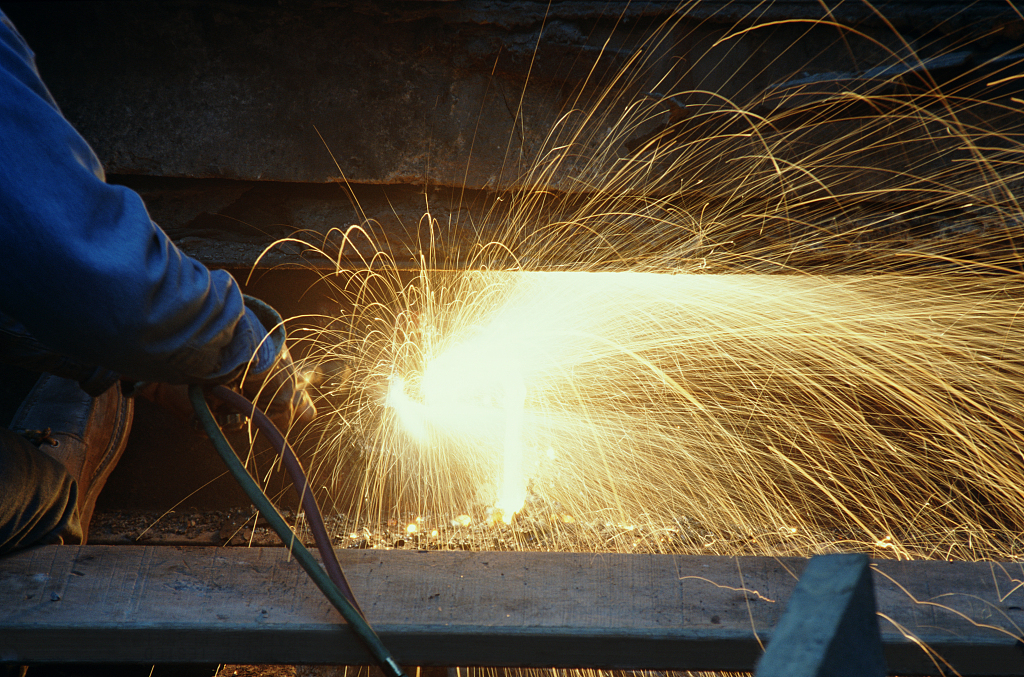

U.S. President Donald Trump tours the U.S. Steel Corp. Granite City Works facility in Granite City, Illinois, July 26, 2018. /VCG Photo
U.S. President Donald Trump campaigned on the promise to revitalize American manufacturing during the last election, and one of the industries poised to gain from his trade policies was steel. However, as the real impacts of an ongoing trade war set in, U.S. steel companies are now feeling the pinch like everyone else.
In a recent speech in Pennsylvania, Trump claimed to have turned a "dead" steel industry into a "thriving" business, because he "put a little thing called a 25 percent tariff" on foreign imports, referring to the Section 232 tariffs he imposed on imported steel in March 2018.
Earlier, the president gave himself credits for putting steel workers back to work. "If I hadn't been elected, you would have no steel industry right now. It would be gone," Trump said at a "Made in America" event in July.
Meanwhile last week, U.S. Steel announced its plans to lay off around 350 workers at two of its facilities in Michigan and Indiana, citing market conditions. The steelmaker's share price hit a record high of 45.39 U.S. dollars in March last year. Today it's a little over 11 U.S. dollars - a 76 percent drop.
There are more bad news. Two other big producers, Nucor and Steel Dynamics, also saw their stocks plunge by a third and half from last year's peaks respectively.

Workers listen as U.S. President Donald Trump, not pictured, speaks at the U.S. Steel Corp. Granite City Works facility in Granite City, Illinois, July 26, 2018. /VCG Photo
The steel industry is a prime example of Trump's vision for American manufacturing, and a showpiece for his trade war.
In 2016, Trump's blue-collar base in the Midwest helped the Republican candidate narrowly capture key swing states, including Michigan, where steel jobs are concentrated. Since the trade war began last year, steel executives and organizations have cheered on Trump's controversial tariffs, which they believed have leveled the playing field for domestic producers.
The Steel Manufacturers Association (SMA), representing over 75 percent of the country's steel-making capacity, applauded Trump in a statement following the president's 2018 State of the Union Address to the Nation, and urged the administration to not delay in "taking meaningful action under Section 232."
In March 2018, Trump announced 25 percent tariffs on imported steel under Section 232 of the Trade Expansion Act. U.S. steel imports dropped around 12 percent last year.
Nucor's and Steel Dynamics' CEOs said 2018 was "a record year" for their companies, and AK Steel's and U.S. Steel's CEOs said it was the best in the last 10 years. Steel stocks surged last year.

U.S. President Donald Trump shows his signature on a proclamation to apply tariffs to steel and aluminum imports at the White House, Washington, D.C., March 8, 2018. /VCG Photo
Propped up by protectionist policies and increased demand, U.S. steelmakers were prompted to expand production capabilities and upgrade facilities. About 5,000 jobs in steel were added in the year after the implementation of those tariffs, according to official data.
Trump made good on his promise to protect American jobs, and frequently touted the steel industry as his trade war win. Trump visited U.S. Steel's Granite City facility last year, followed by a 750-million-U.S. dollar investment by the company to revamp its Gary plant in Indiana.
However, the high production has contributed to overcapacity in the industry and the decline in U.S. steel prices this year. This combined with a slowdown of global economy and rising trade tensions, means that the U.S. steel boom was short-lived.
After the trade war with China escalated this year, market sentiment turned negative quickly. U.S. indexes slumped across the board in recent weeks after Trump told companies to move out of China, which then announced retaliatory tariffs on U.S. goods.
While steel producers may be happy, their end-users are not. Industries that have been hit by the trade war, such as automotive, construction, energy and farm machinery, all ended up hurting steel demand.
Being close to the end-use markets was a major advantage for U.S. steelmakers, Nucor's CEO noted in an interview with CNBC in March.
Less than a year after JSW Steel lauded the tariffs, the company is suing the Commerce Department for failing to exempt it from tariffs on steel-slab raw materials, which the steelmaker has to import from India and Mexico, Bloomberg reported.
The initial benefits from Trump's tariffs on steel imports are also waning, as U.S. trading partners targeted by Section 232 actions could be exempted from those tariffs later. In May 2019, the Trump administration reached a deal with Canada and Mexico to lift the steel and aluminum tariffs, paving the road for the ratification of a new trade agreement to replace the North American Free Trade Agreement (NAFTA).
As for jobs, experts believe the long-term decline in employment will be inevitable, just like everything else changed by technology.

A worker working at a steel mill in the U.S. /VCG Photo
Now the optimism spurred by protective trade policies is fading. U.S. steelmakers and industry experts expressed unease at a recent conference in Atlanta.
"The reality is they're shelling out a lot of money for these improvements, and our view is that over the next several years you’re going to have sustained lower prices," said Bank of America analyst Timna Tanners. She forecasts that prices for hot-rolled coil, a kind of steel used for construction and in the auto industry, will fall even further in 2022.
"We need more stability and certainty in our public policy, and that's the one thing all companies like, whether you're a 21st Century steelmaker or you're in another industry," said SMA President Philip Bell. "You want certainty so you can plan investments and hire people."
Experts say the U.S. steel industry reflects classic supply and demand. It follows consumption and construction activity, and global markets.
U.S. markets rallied on Thursday after China expressed hope in trade negotiations. Steel stocks immediately showed signs of rebound on the back of renewed optimism.
The steel industry has stood firmly by Trump in his tumultuous trade war. But like other American interests, Trump was prepared to sacrifice in order to win, they are still part of a larger economy disrupted by uncertainties.
The International Monetary Fund said last month that global trade in the first quarter of 2019 was the slowest since 2012.
As investor Warren Buffett wrote in his 2018 annual letter, "Americans will be both more prosperous and safer if all nations thrive." That might just hold true for Trump's loyal supporters too.

Copyright © 2018 CGTN. Beijing ICP prepared NO.16065310-3
Copyright © 2018 CGTN. Beijing ICP prepared NO.16065310-3